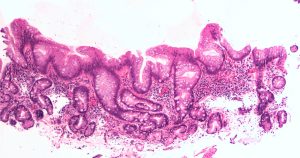What’s Barrett’s Esophagus?
Barrett’s esophagus is a complication of chronic acid reflux, also known as gastroesophageal reflux disease (GERD). Acid reflux occurs when stomach acid backs up into your esophagus.
 This frequently results in heartburn and can occasionally cause damage to the lining of the esophagus. When you struggle with ongoing heartburn, you may want to consider scheduling an appointment with a GI doctor at Digestive Health Centers to determine if it is related to Barrett’s Esophagus. Make an appointment at any of our six locations in Texas today, including Plano, Allen or Dallas.
This frequently results in heartburn and can occasionally cause damage to the lining of the esophagus. When you struggle with ongoing heartburn, you may want to consider scheduling an appointment with a GI doctor at Digestive Health Centers to determine if it is related to Barrett’s Esophagus. Make an appointment at any of our six locations in Texas today, including Plano, Allen or Dallas.
Stomach acid can cause damage to your esophagus because the lining in your esophagus is not able to protect itself against gastric acid. As the esophagus tries to heal, your cells may change in order to adapt and protect the esophagus. These changes can increase your risk of developing esophageal cancer.
Metaplasia
One change that can occur is metaplasia: the process of the reversible substitution of a distinct kind of cell with another mature cell of another kind. This occurs when the body starts growing intestinal cells, rather than esophageal cells, in the esophagus because of the acid influx. If the doctor removes the stimulus that causes the metaplasia, tissues can return to their normal pattern of differentiation. If a metaplasia is not addressed in a timely fashion, it can become dysplasia and/or turn cancerous.
Dysplasia
Dysplasia comes from the root Greek term meaning “bad formation.” It is the term used to refer to an irregularity that hinders cell maturation within a particular tissue. Dysplasia is the earliest form of pre-cancerous lesions recognizable in a biopsy, and doctors typically refer to it as low-grade dysplasia or high-grade dysplasia. Low-grade dysplasia means that the cells show small signs of change, while high-grade dysplasia represents a more advanced condition which may progress to esophageal cancer.
Although the risk of esophageal cancer is small, monitoring of Barrett’s esophagus focuses on periodic exams to find precancerous esophagus cells. If precancerous cells are discovered, they can treat, through procedures such as ablation, to prevent esophageal cancer.
Symptoms of Barrett’s esophagus
- Frequent heartburn
- Difficulty swallowing food
- Chest pain
- Upper abdominal pain
- Dry cough
These symptoms for Barrett’s are similar to acid reflux symptoms; however, many people with Barrett’s have no signs or symptoms.
Risk Factors for Barrett’s esophagus
- Chronic heartburn and acid reflux- having these symptoms of GERD for more than 10 years can increase the risk of Barrett’s esophagus
- Gender- Men are more likely to develop Barrett’s esophagus
- Race- White people have a greater risk of the disease than do people of other races
- Age- Barrett’s esophagus is more common in older adults, but it can occur at any age
Tests to Diagnose Barrett’s esophagus
Doctors can perform an upper endoscopy to diagnosis Barrett’s and determine what degree of dysplasia has occurred in your cells. During the procedure, the doctor can examine the esophagus and remove tissue samples for testing.
Treatment for Low-Grade Dysplasia of Barrett’s esophagus
- Maintain a healthy weight
- Eat smaller, more frequent meals
- Avoid tight fitting clothes
- Eliminate heartburn triggers
- Avoid stooping or bending
- Avoid lying down after eating
- Raise the head of your bed
- Quit smoking
Treatment for High-Grade Dysplasia of Barrett’s esophagus
- Surgery to remove the esophagus
- Removing damaged cells with an endoscope
- Using heat to remove abnormal esophageal tissue
- Using cold to destroy abnormal esophagus cells
- Destroying damaged cells by making them sensitive to light
If you undergo treatment, other than surgery to remove your esophagus, there is a chance that Barrett’s esophagus can recur. For this reason, your doctor may recommend continuing to take acid-reducing medications and having periodic endoscopy exams.
